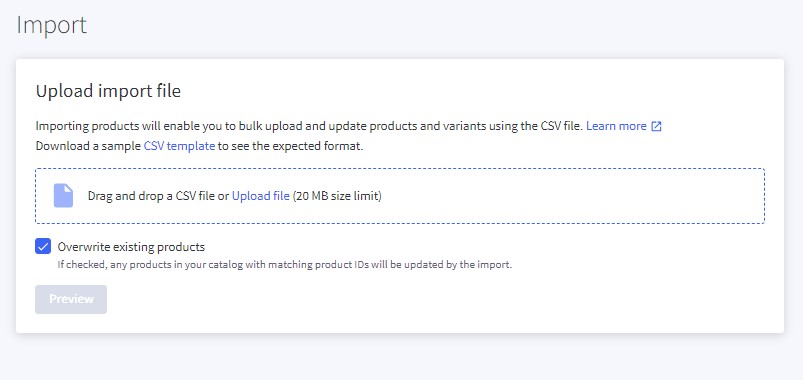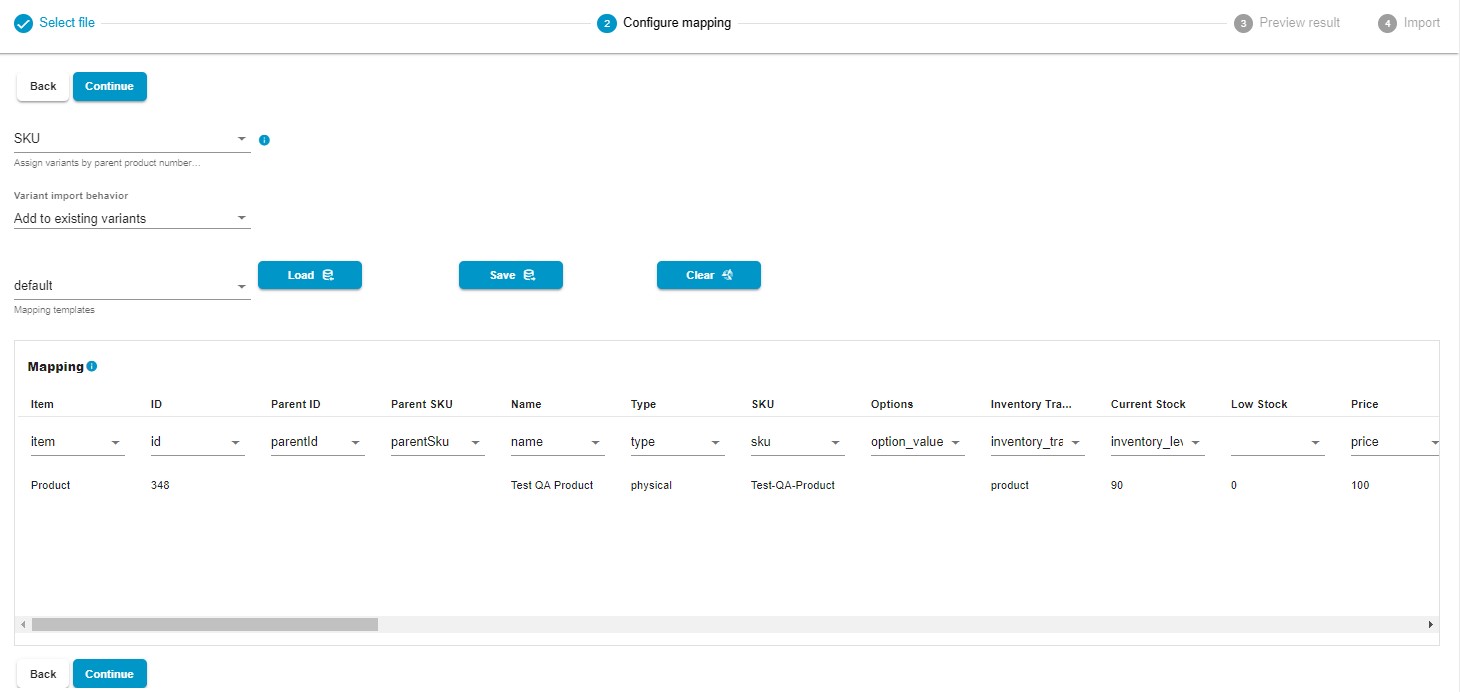BigCommerce Import From URL: Update Your Products & Customers With Ease

What’s more important than data management when it comes to a BigCommerce store? Well, many things, but efficiently managing data is always pivotal, especially when dealing with frequent changes and a fast-paced e-commerce environment. The conventional method of manual imports is associated with numerous restrictions. It is time-consuming and limited in terms of sources of your update, to name a few. However, you can address these and multiple other issues with the – a game-changer for e-commerce businesses. In this comprehensive guide, we delve deep into the realm of BigCommerce file imports from URLs, shedding light on how this powerful strategy can save you precious time and boost the overall efficiency of your online store. We will explore the benefits of BigCommerce URL imports and show you how to import customers and products to BigCommerce from a URL. And be sure to explore our BigCommerce Cookbook for additional valuable insights.
Table of contents
Standard BigCommerce Import
Let’s delve into the standard BigCommerce import procedure, a fundamental method for updating data on your e-commerce site. This method, however, doesn’t support URL uploads. The default process consists of the following steps:
- Access Your BigCommerce Admin: Log in to your BigCommerce admin panel to get started.
- Navigate to the Section You Want to Update: Within the BigCommerce admin, locate and access the section you intend to update, featuring its “Import” subsection.
- Select Your Data File: Choose the data file you want to import. Ensure it meets BigCommerce’s requirements by being in a compatible CSV format with supported attributes.

- Complete the Update: After manually selecting the file, you can preview it. Then, initiate the upload by clicking the “Import” button if everything looks okay.
While the standard BigCommerce import process offers a straightforward means of managing e-commerce data, it doesn’t support URL imports. Consider an alternative approach involving the Firebear Import & Export Tool for more advanced features and efficiency. Before diving into that, let’s explore the benefits of BigCommerce URL imports over manual file uploads.
Advantages of URL Imports in BigCommerce
When considering BigCommerce URL imports, you can harness various benefits to suit your unique e-commerce needs. Let’s delve into the key advantages:
- Efficiency Boost: Importing products from a remote URL proves more efficient than manual uploads, especially when you automate the process using schedules. The more imports you have to conduct, the more work needs to be done in the case of manual uploads. But automated BigCommerce imports from a URL address them.
- Real-time Updates: Importing from a remote URL provides real-time automated updates if your partner places the update file to the same URL address. You can discuss a particular time for the file to be updated. Then create a schedule for your import job to transfer the new data automatically.
- Centralized Management & Multi-Channel Selling: If your products are listed across different platforms or supplier websites, importing from remote URLs allows for centralized management. Changes from suppliers or sources automatically reflect in your BigCommerce store without manual intervention.
- Integration with ERPs & Other Systems: Businesses utilizing Enterprise Resource Planning (ERP) systems and other instruments can incorporate URL imports as part of a broader integration strategy. This approach ensures smooth communication between your e-commerce platform and other vital business processes.
- Effortless Expansion: Streamline the onboarding process when expanding your product catalog or collaborating with new suppliers by leveraging the capability to import from remote URLs. This method enhances efficiency and reduces labor-intensive tasks.
How to Import Products & Customers to BigCommerce from URL
Let’s dive into importing products and customers into BigCommerce from a URL. It is divided into a few intuitive steps:
Step 1: Create a New Import Profile
It’s a breeze to get started. Just click the“New Profile” button available under “Apps,” then “My Apps,” and “Firebear Import & Export Tool,” followed by “Import.”

Step 2: Configure Basic Import Settings
Now, you’ll find yourself on the first screen of your brand-new import profile, titled “Select File.” Here’s your roadmap to configuring a BigCommerce URL import procedure:

- First things first: name your profile.
- Choose the entity you want to import from a URL. You can import customers or products to BigCommerce from a URL. Support for orders and other entities is coming soon.
- If you need to schedule updates, go ahead and do so. You can automate the URL imports according to the provided timetable.
- If you’re eager to stay in the loop about import results, configure email notifications.
- Now, it’s time to pick your preferred file format. You have these options: XLSX, XML, CSV, or even Google Sheets.
- Select your import source – URL. It could also be a file, FTP, Google Sheets, or Google Drive. Now, specify a public URL where your update is stored, for example, https://example.com/download-me.
- In the “Advanced Settings,” you’ll find the Stock Increment Strategy switch. Toggle it on or off based on your needs. If you think it’s a fit for your case, go ahead and enable the “Reload Product Before Update” feature.
Please keep in mind that when you input a URL for importing, the underlying file type at that address is crucial, as the application cannot handle all file formats. For instance, attempting to use an image URL for CSV import from a URL will result in an error.
To help you avoid this issue, the application verifies the file’s MIME type and refrains from downloading it if the MIME type is incompatible.
MIME type, short for Multipurpose Internet Mail Extension, is a standard that specifies the format of a file. It serves as a fundamental characteristic of a digital resource, influencing its accessibility and usability over time.
Below is a list of MIME types currently supported by the application:
|
1 2 3 4 5 6 7 8 9 10 11 12 13 14 15 16 17 18 19 20 |
"csv" => [ "text/html", "text/csv", "text/comma-separated-values", "text/x-comma-separated-values", "text/tab-separated-values", "application/x-csv", "application/csv", "text/plain", "application/octet-stream" ], "xml" => [ "text/html", "application/xml", "text/xml" ], "xlsx" => [ "application/vnd.ms-excel", "application/vnd.openxmlformats-officedocument.spreadsheetml.sheet" ] |
If you import an unsupported file, the app displays the following error:
Failed! Bad url. mime/type mismatch or max size exceed
Step 3: Configure Mapping
With these basic import settings in the bag, it’s time to fine-tune your mappings. The next screen lets you specify which columns in your imported file match the properties of your products or customers on your BigCommerce site.

Identifying the alignment between columns in your imported file and your product properties in BigCommerce is crucial. If the table structure in your import doesn’t perfectly match BigCommerce’s criteria, no worries – you can easily substitute unsupported column names with the correct ones.
Step 4: Preview Import Results
With the Import & Export Tool for BigCommerce, you get a sneak peek of how your products will look after the import. The preview section provides the ability to check your update before it is imported.

If something looks inappropriate, return to the previous step and address the issues.
Step 5: Start Import
Now, click “Save” to store your new import profile. If you’ve created a schedule, the app will take care of the import process automatically according to it. Give the “Import” button a click to launch your BigCommerce customer or product import from the URL immediately.
You can find more information in our Firebear Import & Export Tool for BigCommerce User Manual.
Other Features
Running a BigCommerce store? Well, meet your perfect companion – the Firebear Import & Export Tool. It’s not just about making importing and exporting a breeze; it’s about equipping you with tools and features that go beyond the capabilities of the standard BigCommerce setup. Let’s explore how it revolutionizes the game:
- Effortless Product Management: Keeping your product information up-to-date is a walk in the park. Easily manage product data and custom properties with unparalleled ease.
- Smooth Customer Data Handling: No more juggling customer details. Importing and exporting customer info is as easy as pie, making customer relationship management a breeze.
- Order Insights: Exporting order data is a snap. Gain valuable insights to understand transactions and delve into detailed sales analytics effortlessly.
- Precision Data Mapping: Craft precise data connections for seamless data flow between your BigCommerce store and other systems.
- Customizable Schedules: Tired of manual data updates? Customize your import and export schedules, letting the tool take care of the heavy lifting.
- File Format Flexibility: No file format restrictions here. This tool plays well with different formats like CSV, XML, and XLSX, ensuring silky-smooth data transitions.
- Google Sheets Collaboration: Collaborative data management is a breeze with seamless integration between BigCommerce and Google Sheets. Sharing and working together on data has never been easier.
- Effortless File Uploads: Ditch the complications. Importing and exporting data is as straightforward as direct file uploads, making your data management hassle-free.
- Enhanced Security: Concerned about data security? Rest easy. The tool supports secure FTP/SFTP protocols, providing extra peace of mind during data transfers.
- Google Drive Integration: Google Drive integration adds a layer of convenience and accessibility to the entire process.
The Firebear Import & Export Tool redefines how BigCommerce store owners handle their data transfer operations. Whether it’s maintaining your product catalog, managing customer data, or handling orders, this app simplifies complex tasks, ultimately supercharging your online store’s efficiency. Ready to learn more? Dive deeper into this fantastic tool by visiting:
